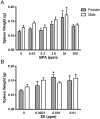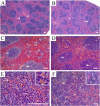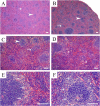Impacts of Bisphenol A and Ethinyl Estradiol on Male and Female CD-1 Mouse Spleen
- PMID: 28404993
- PMCID: PMC5429804
- DOI: 10.1038/s41598-017-00961-8
Impacts of Bisphenol A and Ethinyl Estradiol on Male and Female CD-1 Mouse Spleen
Abstract
The endocrine disruptor bisphenol A (BPA) and the pharmaceutical 17α-ethinyl estradiol (EE) are synthetic chemicals with estrogen-like activities. Despite ubiquitous human exposure to BPA, and the wide-spread clinical use of EE as oral contraceptive adjuvant, the impact of these estrogenic endocrine disrupting chemicals (EDCs) on the immune system is unclear. Here we report results of in vivo dose response studies that analyzed the histology and microstructural changes in the spleen of adult male and female CD-1 mice exposed to 4 to 40,000 μg/kg/day BPA or 0.02 to 2 μg/kg/day EE from conception until 12-14 weeks of age. Results of that analysis indicate that both BPA and EE have dose- and sex-specific impacts on the cellular and microanatomical structures of the spleens that reveal minor alterations in immunomodulatory and hematopoietic functions. These findings support previous studies demonstrating the murine immune system as a sensitive target for estrogens, and that oral exposures to BPA and EE can have estrogen-like immunomodulatory affects in both sexes.
Conflict of interest statement
The authors declare that they have no competing interests.
Figures



Similar articles
-
Estrogen-like disruptive effects of dietary exposure to bisphenol A or 17α-ethinyl estradiol in CD1 mice.Int J Toxicol. 2012 Nov-Dec;31(6):537-50. doi: 10.1177/1091581812463254. Epub 2012 Nov 15. Int J Toxicol. 2012. PMID: 23160314 Free PMC article.
-
Hypothalamic transcriptomic alterations in male and female California mice (Peromyscus californicus) developmentally exposed to bisphenol A or ethinyl estradiol.Physiol Rep. 2017 Feb;5(3):e13133. doi: 10.14814/phy2.13133. Physiol Rep. 2017. PMID: 28196854 Free PMC article.
-
Gene expression and DNA methylation changes in the hypothalamus and hippocampus of adult rats developmentally exposed to bisphenol A or ethinyl estradiol: a CLARITY-BPA consortium study.Epigenetics. 2018;13(7):704-720. doi: 10.1080/15592294.2018.1497388. Epub 2018 Aug 15. Epigenetics. 2018. PMID: 30001178 Free PMC article.
-
Effects of the environmental estrogenic contaminants bisphenol A and 17α-ethinyl estradiol on sexual development and adult behaviors in aquatic wildlife species.Gen Comp Endocrinol. 2015 Apr 1;214:195-219. doi: 10.1016/j.ygcen.2014.09.014. Epub 2014 Sep 30. Gen Comp Endocrinol. 2015. PMID: 25277515 Review.
-
Bisphenol A and human health: a review of the literature.Reprod Toxicol. 2013 Dec;42:132-55. doi: 10.1016/j.reprotox.2013.08.008. Epub 2013 Aug 30. Reprod Toxicol. 2013. PMID: 23994667 Review.
Cited by
-
Vitamin D mitigates adult onset diseases in male and female mice induced by early-life exposure to endocrine disruptor BPA.Open Vet J. 2021 Jul-Sep;11(3):407-417. doi: 10.5455/OVJ.2021.v11.i3.12. Epub 2021 Aug 12. Open Vet J. 2021. PMID: 34722204 Free PMC article.
-
Modulation of folliculogenesis in adult laying chickens by bisphenol A and bisphenol S: Perspectives on ovarian morphology and gene expression.Reprod Toxicol. 2021 Aug;103:181-190. doi: 10.1016/j.reprotox.2021.06.010. Epub 2021 Jun 18. Reprod Toxicol. 2021. PMID: 34147626 Free PMC article.
-
Association of Urinary Bisphenols Concentration with Asthma in Korean Adolescents: Data from the Third Korean National Environmental Health Survey.Toxics. 2021 Nov 4;9(11):291. doi: 10.3390/toxics9110291. Toxics. 2021. PMID: 34822682 Free PMC article.
-
Re-evaluation of the risks to public health related to the presence of bisphenol A (BPA) in foodstuffs.EFSA J. 2023 Apr 19;21(4):e06857. doi: 10.2903/j.efsa.2023.6857. eCollection 2023 Apr. EFSA J. 2023. PMID: 37089179 Free PMC article.
-
Exposure to low-dose bisphenol A induces spleen damage in a murine model: Potentially through oxidative stress?Open Vet J. 2022 Jan-Feb;12(1):23-32. doi: 10.5455/OVJ.2022.v12.i1.4. Epub 2022 Jan 7. Open Vet J. 2022. PMID: 35342727 Free PMC article.
References
-
- World Health Organization. Toxicological and health aspects of bisphenol Ahttp://www.who.int/foodsafety/publications/bisphenol-a/en/ (2011).
-
- Global Industry Analysts. Global Bisphenol-A Market to Grow 5.17% by 2020 - Low Oil Prices Affecting Upstream Value Chain - Research and Markets, http://www.prnewswire.com/news-releases/global-bisphenol-a-market-to-gro... (2016).
Publication types
MeSH terms
Substances
Grants and funding
LinkOut - more resources
Full Text Sources
Other Literature Sources

